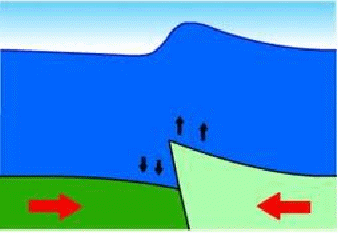Tsunamis are seismic sea waves, essentially pressure waves. The speed of surface water waves is typically a few metres per second, but the speed of tsunami and pressure waves is much higher – several thousand metres per second. They are caused by most often by earthquakes but may also be caused by landslides at sea or volcanoes. Not every earthquakes creates tsunamis. In order for a tsunami to be created, movement must be produced in a vertical direction.

Tsunamis carry large amounts of energy and can the pressure waves can permeate whole oceans. When they reach coastline or shallow water their energy becomes concentrated. The wave height of maybe 50cm at sea can increase to several tens of metres on the coastline. This is because as the wave nears the coast, it slows. The back of the wave catches up with the front ant the amplitude gets higher. The small amplitude out at sea may make people unconcerned, but the rapid speed and increase in amplitude as the tsunami reaches land puts people in great danger.
Tsunamis are more dangerous because water is essentially incompressible. This means that the speed of the tsunami is high and the water is not able to absorb the energy by compression and dissipate it on a longer timescale.